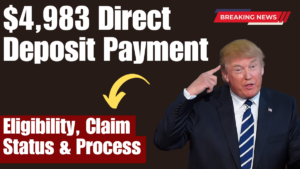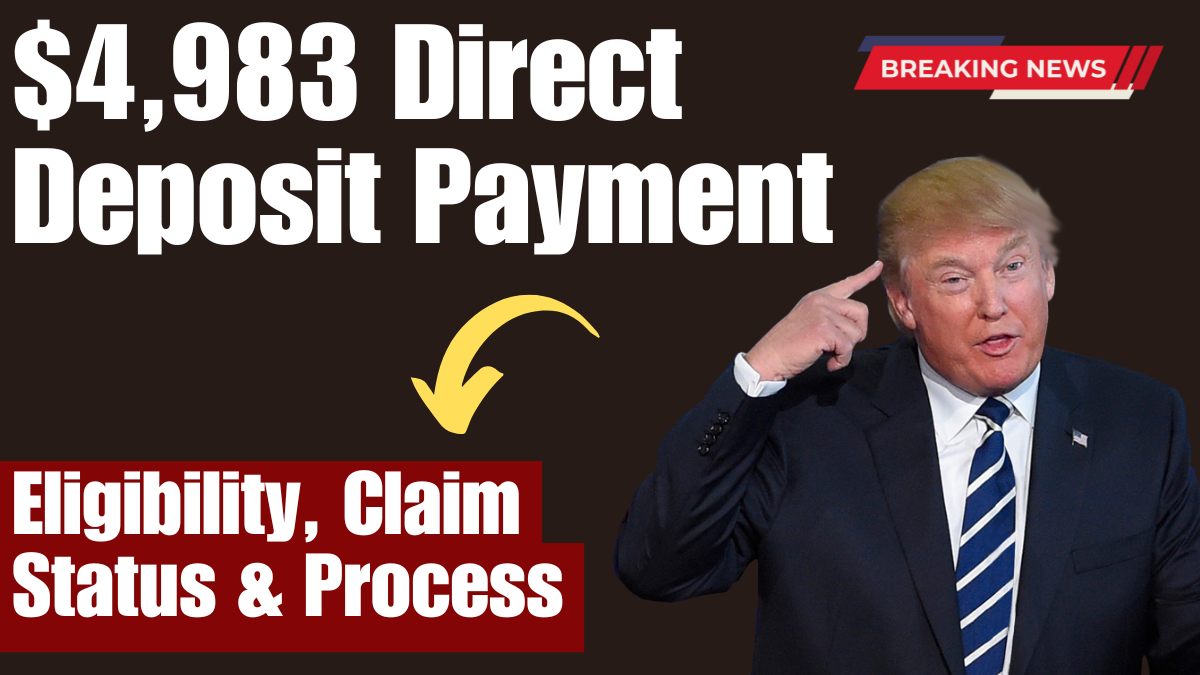Government-backed financial support plays a vital role in helping Americans manage living costs, medical bills, or job loss. With talks about the $4,983 direct deposit payment circulating in April 2025, many are eager to understand where it’s coming from, who is eligible, and how to claim it.
While this exact amount is not tied to a single nationwide benefit, several federal and state-level programs may lead to a lump-sum or monthly payment that could total this amount. Here’s everything you need to know.

Types of Direct Deposit Payments You Could Receive
Several existing and ongoing assistance programs may result in a direct deposit close to or exactly $4,983, depending on your eligibility:
-
Social Security and SSDI Payments
-
Average monthly Social Security: $1,907
-
SSDI (Disability Insurance): Around $1,580 per month
-
2025 COLA (Cost-of-Living Adjustment): 2.5% increase
-
Additional support for qualifying dependents or survivors
-
-
Tax Refunds and Recovery Rebates
-
Over 1.1 million Americans have unclaimed refunds from previous years
-
2021 tax refund deadline: April 15, 2025
-
Refunds and credits may be combined for qualifying individuals
-
Eligibility Criteria for Receiving the Payment
To qualify for one or more of these payments, recipients typically must meet income and other program-based thresholds:
-
Single filers: Adjusted Gross Income (AGI) below $75,000
-
Married couples: AGI below $150,000
-
Phase-out thresholds: Up to $80,000 (single) or $160,000 (married)
-
Heads of households and families with dependents may have additional considerations
Applicants must also ensure they are current on tax filings and not disqualified due to federal or state debt offsets.
How to Claim the Direct Deposit Payment
The process to receive payments from various programs generally includes the following steps:
-
Verify Your Eligibility through official portals like SSA.gov or IRS.gov
-
File Tax Returns for previous years if applicable
-
Update Direct Deposit Details with accurate bank information
-
Create an IRS Online Account to manage communication
-
Submit Required Documentation such as identity, income, and address proofs
MUST READ: $1,673.24 CPP Disability Benefit Coming in April 2025 – Payment Date & Eligibility
Required Documentation Checklist
To avoid delays or rejection, have these documents ready:
-
Social Security Numbers (SSN) for all claimants
-
Recent tax returns (2022, 2023, or 2024)
-
W-2s, 1099s, or proof of income
-
Proof of disability (if applying for SSDI)
-
Valid photo ID and proof of current residence
-
Updated bank account details for direct deposit
Special Considerations in April 2025
Several important factors may impact the receipt of your payment:
-
Unfiled returns may delay or cancel your eligibility
-
Outstanding federal or state debts could reduce or offset your payout
-
Eligibility criteria are subject to change through legislative updates
-
Processing delays may vary based on documentation and program review
State-Level Programs to Maximize Your Benefit
Many states supplement federal programs through:
-
Supplemental unemployment benefits
-
Emergency housing or utility assistance
-
Stimulus or crisis response funds targeting local communities
-
Property tax relief for low-income homeowners, veterans, or seniors
These benefits often align with federal efforts, potentially pushing your total received funds toward or beyond $4,983 in April.
Technological Enhancements in Direct Deposit Systems
Digital infrastructure for payments continues to evolve with added security:
-
Biometric and AI-based ID verification
-
Blockchain-based tracking of fund transfers
-
Real-time processing via modern ACH systems
-
Multi-factor authentication to prevent fraud
These innovations are designed to reduce errors and ensure your payment reaches you without delay.
FAQs
Who is eligible for the $4,983 direct deposit payment?
There is no single $4,983 benefit. This amount may result from a combination of Social Security, SSDI, tax refunds, or state-level assistance programs. Eligibility varies by program.
When will the payment arrive?
Most direct deposit payments are processed by the IRS or SSA near the end of the month. If linked to a tax refund or SSDI, payments may arrive by April 28, 2025.
What happens if I haven’t filed my taxes?
Unfiled tax returns can block your access to many benefits. If you’re due a refund or eligible for tax credits, file before the April 15, 2025 deadline.
Can I still receive the payment without direct deposit?
Paper checks are still issued but may take longer. Setting up direct deposit ensures faster and more secure delivery.
Will this impact other benefits I receive?
It depends. Some income-based benefits may be reduced temporarily if your total support exceeds thresholds. Always check with your benefits administrator.
Conclusion
While the $4,983 direct deposit is not a guaranteed universal benefit, it’s entirely possible to receive such an amount through a combination of federal and state programs in April 2025. From Social Security to unclaimed tax refunds, opportunities for financial support are available—but require attention to detail, timely filing, and eligibility documentation.
Keep your records organized, stay updated on deadlines, and monitor official government portals for alerts. With proactive planning, you can secure the financial aid you’re entitled to.
Click here to know more.
